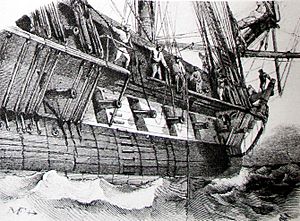Sounding line facts for kids

Measuring the water depth on a frigate, illustration of 1844.
A sounding line is a simple tool used to measure how deep water is. Imagine a heavy weight tied to a long rope. Sailors and scientists use this tool to find out the depth of water in oceans, lakes, or rivers. It helps them understand the underwater world and navigate safely.
Contents
What is a Sounding Line?
A sounding line is a basic device for measuring water depth. It works by lowering a weighted line until it touches the bottom. The length of the line that gets wet tells you the depth. This method has been used for thousands of years. It was very important for ships to avoid shallow areas.
How Does a Sounding Line Work?
Using a sounding line is quite simple.
- First, a heavy weight, often made of lead, is tied to one end of a strong rope.
- The rope is marked at regular intervals, like every foot or meter.
- A sailor or explorer lowers the weight into the water.
- They keep lowering it until they feel the weight hit the bottom.
- Then, they pull the line back up and check the markings.
- The number at the water's surface shows the depth.
Why Do We Measure Water Depth?
Measuring water depth, also called "sounding," is very important for many reasons.
- Safe Travel: Ships need to know how deep the water is to avoid running aground. This means hitting the bottom in shallow areas.
- Making Maps: Sounding lines help create maps of the ocean floor. These maps are called nautical charts. They show depths, underwater features, and safe routes for ships.
- Understanding the Ocean: Scientists use depth measurements to study the shape of the seafloor. This helps them learn about underwater mountains, valleys, and trenches.
- Building Things: When building bridges, docks, or underwater pipelines, knowing the depth is crucial. It ensures structures are built on solid ground.
History of Sounding Lines
People have been measuring water depth for a very long time.
- Ancient sailors used sounding lines to navigate coastal waters. They needed to find safe harbors and avoid dangerous rocks.
- Early lines were simple ropes with stones attached. Over time, lead weights became common.
- In the 19th century, new tools like the sounding machine were invented. These machines made it easier to measure very deep parts of the ocean.
- Today, modern ships use sonar and GPS for much more accurate depth measurements. However, the basic idea of a sounding line laid the foundation for these advanced technologies.
Images for kids

All content from Kiddle encyclopedia articles (including the article images and facts) can be freely used under Attribution-ShareAlike license, unless stated otherwise. Cite this article:
Sounding line Facts for Kids. Kiddle Encyclopedia.



